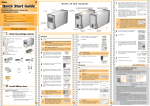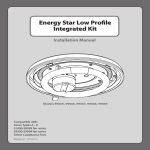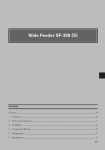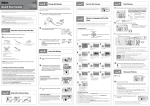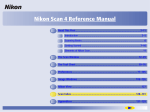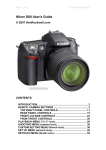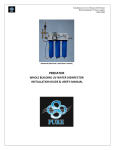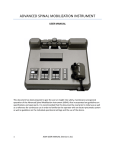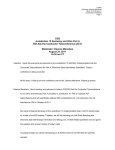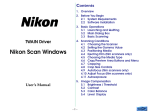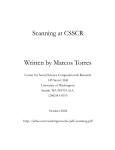Download Quick Start Guide Quick Start Guide
Transcript
Part s of t he Scanner Quick Start Guide Nikon Film Scanner AC connector If you need help: e After reading the license agreement, click Accept to accept the agreement and view the ReadMe file. Take a few moments to read this file, which may contain important information that could not be included in the product manuals. Click Continue… to proceed to the next step. f Click Install to begin installation. Nikon Scan 4 will be installed to the folder shown under “Install Location.” In Mac OS X, Nikon Scan 4 is installed to the “Applications : Nikon Software” folder on the start-up disk. The default install location for Mac OS 9 is the “Applications (Mac OS 9) : Nikon Software” folder on the OS 9 start-up disk. Power switch Visit http://www.nikontechusa.com/ or call 1-800-NikonUX (for users in the U.S.A.) Eject button Vist http://www.europe-nikon.com/support (for users in Europe and Africa) Holder slot Visit http://www.nikon-asia.com/ (for users in Asia, Oceania and the Middle East) Visit these sites to keep up-to-date with the latest product information, tips, answers to frequently-asked questions (FAQs), and general advice on digital imaging and photography. Note Status LED If the computer is not already equipped with an IEEE 1394 (Firewire) interface, install the supplied IEEE 1394 interface board. Before Nikon Scan can be installed, users of Windows 98 SE will need to update the IEEE 1394 drivers, install the interface board, and then install the IEEE 1394 interface drivers. For more information, see “Installing the IEEE 1394 (Firewire) Interface Board” on page 64 of the User‘s Manual. Preparation Step 1 Windows Check the package contents Remove the scanner from the box and confirm that you have all the items listed below. 쐃 SUPER COOLSCAN 9000 ED film scanner 쐇 Power cable 쐋 IEEE 1394 (Firewire) cable 쐏 FH-835S 35-mm strip-film holder 쐄 Masking sheets (×2) 쐂 FH-835M 35-mm slide-mount holder 쐆 FH-869S medium-format strip film holder 쐊 IEEE 1394 (Firewire) interface board 쐎 CD-ROM • Nikon Scan CD (Yellow) • Nikon Scan Reference Manual / Easy Scanning Guide CD • Nikon View CD (Yellow) • Nikon View Reference Manual CD 쐅 Warranty 쐈 User’s Manual 쐉 Quick Start Guide (this guide) Important Important b 쐃 Windows XP Home Edition / Windows XP Professional / Windows 2000 Professional When installing or uninstalling Nikon Scan, log in as the “Computer administrator” (Windows XP Home Edition/Windows XP Professional) or “Administrator” (Windows 2000 Professional). Important Windows 98 SE If the computer displays a message stating that an IEEE 1394 update is required, click OK to continue with installation. Once installation is complete and the computer has restarted, update the IEEE 1394 drivers as described on page 65 of the User’s Manual. Click Finish to exit the Nikon Scan installer. l d The opening dialog of the Nikon Scan installer will be displayed. Click Next. Click Macintosh. i A list of color-space profiles will be displayed. Select Apple RGB (recommended) and click OK. For more information on color-space profiles, see page 90 of the Nikon Scan Reference Manual (on CD). j Click Yes to add Nikon Scan 4 to the Dock (Mac OS X) or create an alias of Nikon Scan 4 on the desktop (Mac OS 9). Mac OS X k l 쐇 쐋 h A list of color-space profiles will be displayed. Select sRGB (recommended) and click OK. For more information on color-space profiles, see page 88 of the Nikon Scan Reference Manual (on CD). Earlier Versions of Nikon Scan Before installing Nikon Scan 4, uninstall any earlier versions of Nikon Scan. See “Uninstalling Nikon Scan” on pages 70–72 of the User’s Manual. Insert the Nikon Scan CD in the CD-ROM drive. After a brief pause, a language selection dialog will be displayed. Select a language and click Next. g The opening dialog of the color space selection wizard will be displayed. Click Use Wizard. Click Windows. k The “Welcome” dialog will be displayed. Click the “Software” tab and click Install. c The opening dialog of the color space selection wizard will be displayed. Click Use Wizard. i j Turn the computer on and wait for Windows to start up. Do not connect the scanner. a m Mac OS 9 Click Quit to exit the installer. Click Restart to restart the computer. Click Yes to restart the computer. See Other Side Macintosh 쐏 쐄 쐂 Important CD-ROM CD-ROM CD-ROM CD-ROM M M M M 쐆 쐊 The default install location for Nikon Scan (c: \Program Files\Nikon\Nkscan4) is displayed under “Destination location.” To choose a different location, click Browse… and navigate to the desired folder. Click Next to begin installation. f ROM CDDROM CDD- ROM CDDROM CDD- -ROM C CD -ROM C CD -ROM C CD -ROM C CD 쐎 Important The dialog shown at right will be displayed. Click Yes to create the destination folder for Nikon Scan. En Fr Es Nikon Film Scanner En Quick Start Guide b c If you need help: Warranty Visit http://www.nikontechusa.com/ or call 1-800-NikonUX (for users in the U.S.A.) g Vist http://www.europe-nikon.com/support (for users in Europe) User's Manual Manuel de I'utilisateur Visit http://www.nikon-asia.com/ (for users in Asia, Oceania, the Middle East, and Africa) Manual del Usuario 쐅 Step 2 쐈 쐉 When prompted to select the scanner drivers, confirm that LS- 4000/8000/9000 is selected and click Next. d Install Nikon Scan Before connecting the scanner, install Nikon Scan as described below. Note Supported operating systems Windows Macintosh • Windows XP Home Edition/Professional • Windows 2000 Professional • Windows Millennium Edition (Me) • Windows 98 Second Edition (SE) h Note Continued above at right Mac OS X Administrator privileges are required to install or uninstall Nikon Scan. This CD contains the Nikon Scan Reference Manual, which provides complete information on Nikon Scan, and the Easy Scanning Guide, an animated guide introducing such basic scanning tasks as setting image size and resolution. Mac OS 9 CarbonLib 1.6 or later is required to install Nikon Scan 4. If the installer detects an earlier version, a message will be displayed. Click Install to upgrade to a new version of CarbonLib. Be sure to restart the computer before continuing the installation. Easy Scanning Guide* Nikon Scan Reference Manual Insert the Nikon Scan 4 CD in the CD-ROM drive. Double-click the Welcome icon ( ) in the root directory of the Nikon Scan 4 CD. Windows† • Viewing the Nikon Scan Reference Manual Double-click the manual.pdf icon on the reference manual CD. Adobe Acrobat Reader will start and a language selection screen will be displayed; click the appropriate link to view the manual in the desired language. Note that Adobe Acrobat Reader 4 or later is required to view the Reference Manual; Windows users can install Acrobat Reader 5 from the “Acrobat Reader” folder on the reference manual CD. • Viewing the Easy Scanning Guide Double-click the easy_guide.exe icon (Windows), easy_guide_OSX icon (Mac OS X), or easy_guide_OS9 icon (Mac OS 9). The Macromedia Flash Player will start and a language selection screen will be displayed; click the appropriate link to view the guide in the desired language. The Easy Scanning Guide can also be copied to the computer hard disk for ease of reference. Copy the “easy_guide_main” folder and easy_guide.exe (Windows), easy_guide_OSX (Mac OS X), or easy_guide_OS9 (Mac OS 9) to the desktop*. The “Welcome” dialog will be displayed. Click the “Software” tab and click Easy Install. Windows 2000 Professional The dialog shown at right will be displayed; click Yes (if the dialog is displayed twice, click Yes each time). Associating Image Enhancement Extensions with Nikon Scan If Nikon Capture or other Nikon software is already installed on the computer, a dialog will be displayed requesting permission to associate image enhancement settings file extensions with Nikon Scan. Click Yes. Continued above at right Note Mac OS X Clicking Install displays the “Authenticate” dialog shown at right. Enter the administrator name and password and click OK. Macintosh * Icons may differ. † Extensions may not be displayed in some environments. A language selection dialog will be displayed. Select a language and click Next. Click Yes to create a shortcut to Nikon Scan on the desktop. • Mac OS X (version 10.1.5 or later) • Mac OS 9 (version 9.1 or later) Other system requirements are detailed on page 10 (Windows), 15 (Macintosh) of the User’s Manual. Nikon Scan Reference Manual / Easy Scanning Guide CD Turn on the computer and wait for it to start up. Do not connect the scanner. a After reading the license agreement, click Yes to accept the agreement and proceed with installation. e M CD-RO RO M CD-R O RO M CD-RO RO M CD-RO RO Note IEEE 1394 (Firewire) connector If Multiple Copies of Photoshop Are Installed (Mac OS 9 Only) If a copy of the Nikon Scan plug-in is installed in the plug-ins folders for supported versions of Adobe Photoshop, Photoshop can be used to acquire images directly from the scanner. If more than one copy of Photoshop is installed on the computer, a list of plug-ins folders will be displayed. Select the plug-ins folders for the copies of Photoshop that will be used to acquire images and click Continue to copy the Nikon Scan plug-in to the selected folders. Continued above at right * Users of Mac OS X should ensure that the start-up disk is named using only letters and numbers (the default name for the start-up drive is “Macintosh HD”). The guide may not start if the volume name contains punctuation or other non-alphanumeric characters. Scanning Place medium-format film in the holder. b b Place the film with the reflective base up and the matte emulsion surface down. Make sure the film is flush with the stops. This side of the guide describes how to connect the scanner to the computer and scan images using Nikon Scan. Be sure to complete the steps on the other side of this guide before proceeding. Select the frames to be scanned. Click the Scan button to scan the image. When scanning is complete, the image will be opened in an image window. The image in the image window will reflect any rotations, flips, and other modifications made in the scan window. e Thumbnail drawer tab Click the thumbnail drawer tab. Stops Step 3 a After confirming that the power switch is in the off position, connect the power cable as shown and plug the scanner into a general-purpose household outlet. Connect the scanner The thumbnail drawer will open. The frames in the film are identified by frame number. To view each frame as a small “thumbnail” preview, click the button. Press the covers down until they latch. c Shape of plug varies with country or region of purchase Click to display thumbnails Thumbnail area Click to hide thumbnails Selected thumbnail The frames will be scanned in the order shown at right. Connect the IEEE 1394 (Firewire) cable as shown. b 1 Arrow Step 6 2 Note IEEE 1394 cable connector (cross-section) Start Nikon Scan Note c Note Important Step • Rotate or flip the image in the preview area If the preview image is not in the desired orientation, rotate or flip the image by clicking the , , or button. Rotate image 90° counter-clockwise Flip image horizontally Status LED FH-869S holder for medium-format film strips a Place the film in the holder Depressions Latches Remove the holder from the scanner. To remove the holder, either press the eject button on the front of the scanner or click the Eject button ( ) in the scan window. Eject button Step Continued above at Depressions right Rotate image 90° clockwise Flip image vertically 7 The borders of the crop are indicated by a dotted line. The size of the crop can be changed by dragging its borders. To change the position of the crop, place the cursor inside the selected area and drag it to a new location. Continued above at right a When an image is displayed in the preview area, the “Crop” palette in Tool Palette 1 can be used to specify the size and resolution at which the image will be scanned (for details, see pages 36–40 of the Nikon Scan Reference Manual on the Nikon Scan Reference Manual / Easy Scanning Guide CD). For example, to scan an image so that it can be printed within the margins of A4 (29.7 × 21.0 cm) or letter-sized (11˝ × 8.5˝) paper using a typical inkjet printer, adjust settings as follows:printing: • Do not use force. Failure to observe this precaution could result in damage to the holder or scanner. • Attempting to remove the holder during loading or otherwise interfering with the loading mechanism could cause scanning errors. 8 Click to open the “Crop” palette. Scan Choose Keep this crop. Select 6 × 7 Enter a value for either Height or Width that will fit on A4 or letter-sized paper. The other value will automatically be adjusted to maintain the current crop. The explanation that follows assumes that 6 × 7 negatives have been inserted in the holder. Click the film-type menu and select Neg (Color), then click the frame size menu and select 6 × 7. Continued above at right is selected in the resolutions units menu and enter an output resolution of 360. If Nikon View is installed on the computer, selecting Show Nikon Browser from the Nikon Scan Tools menu will start the Nikon Browser component of Nikon View. Nikon View can be used to view scanned images either as thumbnails or at full size and to edit and print images after scanning. For more information, see the Nikon View Reference Manual (available in pdf format on the Nikon View Reference manual CD) or Nikon View’s on-line help. Select Show Nikon Browser from the Nikon Scan Tools menu Choose cm or inches from the output units menu. Select Neg (Color) Power switch Nikon View (Nikon View 6 or later) For information on the other image enhancement tools in Tool Palette 1, see pages 30–76 of the Nikon Scan Reference Manual (on CD). Tip: Specifying Output Size and Resolution Step Turning the Scanner Off Mac OS / Windows XP / Windows 2000 Professional After checking that the status LED is not blinking, turn the scanner off by pressing the power switch. Windows Me Shut down the computer. Once the computer has turned off, press the power switch to turn the scanner off. Windows 98 SE Click the “Unplug or Eject Hardware” icon in the task bar and select Stop Nikon SUPER COOLSCAN 9000 ED from the menu that appears. A message will be displayed stating that the scanner can be safely removed from the system; click OK and follow the on-screen instructions to terminate communication with the scanner. Press the power switch to turn the scanner off. Insert the holder Check that the status LED has stopped blinking. Keeping the holder straight, slide it slowly into the holder slot with the arrow up and facing toward the scanner. Once the holder has been inserted as far as the insertion guides, the automatic loading mechanism will activate. Remove your hands from the holder when loading starts. The holder is in scanning position when loading stops. Important Turn off the scanner as described below. Status LED Temporary Storage (Windows Only) A message may be displayed stating that the folder selected for temporary storage is not available. Click OK to use the default folder. Note c The procedure for turning the scanner off depends on the computer operating system. Follow the steps below to turn the scanner off. • Select the area to be scanned To select the portion of the image that will be scanned (called the “crop”), click the Crop Tool ( ) in the “Layout Tools” palette and drag the mouse over the image. Mac OS 9 Before using Nikon Scan under Mac OS 9, be sure to read the section on recommended memory allocations on page 139 of the Nikon Scan Reference Manual (on CD). Important b Select Exit (Windows) or Quit (Mac OS 9) from the File menu. In Mac OS X, select Quit Nikon Scan 4 from the Nikon Scan 4 menu. Tool Palette 1 Confirm that pixels/inch Latches a turn the scanner off Click the triangle next to the “Layout Tools” palette in Tool Palette 1. The “Layout Tools” palette will be displayed. The “Layout Tools” palette can be used to: Progress window Scan window Ready the film and holder Insert a finger into the depressions in the holder, release the latches, and open the holder. d Power switch Windows 98 SE Users of Windows 98 SE may be prompted to insert the Windows 98 Second Edition CD when the scanner is connected and turned on for the first time following installation of Nikon Scan. Register the scanner with Windows as described on page 65 of the User’s Manual. 5 9 Click the Preview button to preview the selected frame in the preview area. The scan window will open. The next step is to insert film in the holder. The type of film that can be scanned depends on the holder used. This guide describes how to 6 × 7 medium-format negatives in the supplied FH-869S holder for medium-format (also known as 120/220, 2¼ or Brownie) film strips and 59 mm × 82 mm electron microscope film. The length of the film strip that can be inserted in the holder depends on the type of film: •6 × 4.5 1–4 frames •6 × 6 1–3 frames •6 × 7–6 × 9 1–2 frames Medium-format film strip See the User’s Manual for information on scanning other types of film, including 35mm film strips. Step Eject the film and Step Eject button Nikon Scan can also be started by locating the folder in which Nikon Scan was installed and opening the Nikon Software : Nikon Scan 4 folder. Double-click the Nikon Scan 4 icon ( ). Under Mac OS X, the “Nikon Software” folder will be in the “Applications” folder on the start-up disk. Under Mac OS 9, the default install location is in the “Applications (Mac OS 9)” folder on the start-up disk. Windows 2000 Professional A “Digital Signature Not Found” dialog will be displayed the first time the scanner is connected and turned on. Click Yes to register the scanner with Windows. 4 c The Progress Window The “Progress” window shows the progress of preview and scan operations. Click Stop to cancel the current operation. Macintosh Nikon Scan can be started by clicking the Nikon Scan icon ( ) in the Dock (Mac OS X) or double-clicking the Nikon Scan alias ( ) on the desktop (Mac OS 9). Note that these options are only available if Nikon Scan was added to the Dock or an alias was created during installation. The supplied IEEE 1394 cable can not be connected to computers with a four-pin DV connector. Use a cable with one six-pin and one fourpin connector or a six-to-four pin adapter (sold separately). After making sure that the computer is running, press the power switch to turn the scanner on. The status LED will blink for about two minutes while the scanner initializes. Wait until the status LED glows steadily. The scan window may remain open “on top” of the image window. Drag the scan window to move it out of the way of the image window. To save the image, select Save from the File menu. A “Save As” dialog will be displayed; navigate to the desired location, choose a name and file type, and click Save. f Drag to enlarge thumbnail area Nikon Scan can also be started by clicking the Start button and selecting Nikon Scan 4 > Nikon Scan 4 from the Programs menu. Computer or scanner interface terminal (cross-section) Note Macintosh Direction of insertion Windows If a shortcut was created at installation, double-click the shortcut ( ) created on the desktop. When connecting the cable, align the rounded edge of the connector with the matching curve on the scanner or computer IEEE 1394 (Firewire) interface connector (see illustration below). Using the wrong connector or attempting to insert the connectors in another orientation could not only damage the connector, but also the scanner or computer. Windows A thumbnail will be created for each frame. Click a frame to select it for preview at a larger size in the scan window preview area. Nikon View can be installed from the Nikon View 6 CD. Before you can install Nikon View 6, you must uninstall any earlier versions of Nikon View. Note Nikon View To register your copy of Nikon View, open the “Product Registration” panel in the “Install Center” window and click the Product Registration button (Internet connection required)*. * Not available in some areas. Printed in Japan SB5I00300201(11) 6MRA0911--


